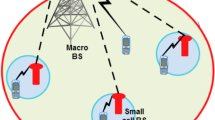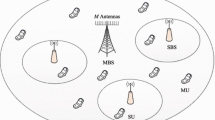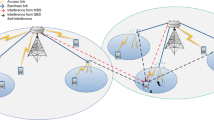Abstract
In this paper, the spectral efficiency of a full-duplex (FD) densely distributed multi-input multi-output (MIMO) system with wireless backhaul is considered. In-band full-duplex (IBFD) backhauling, in which the backhaul and access transmissions take place on the same spectrum, is exploited for wireless backhauling to enable an efficient spectrum reuse. However, the severe cross-tier interference and cross-link interference reduce the gains of IBFD backhauling. To evaluate the achievable spectral efficiency with imperfect channel state information (CSI), we propose a two-phase channel estimation scheme to estimate the CSI for two wireless links, and the scheme estimates an effective interference CSI between access points (APs) based on beamforming training to perform interference cancelation at APs. Given the estimated CSI, the closed-form expressions of the uplink and downlink achievable rates with maximum ratio transmission beamforming and maximum ratio combining receivers, respectively, are derived with Gamma approximation. Numerical results verify the accuracy of the derived closed-form expressions and the effectiveness of the two-phase channel estimation scheme for interference cancelation. Moreover, compared with half-duplex densely distributed MIMO systems, FD systems with interference cancelation have a better performance.
Similar content being viewed by others
References
Li J M, Lv Q, Zhu P C, et al. Network-assisted full-duplex distributed massive MIMO systems with beamforming training based CSI estimation. IEEE Trans Wireless Commun, 2021, 20: 2190–2204
Li J M, Wang D M, Zhu P C, et al. Downlink spectral efficiency of distributed massive MIMO systems with linear beamforming under pilot contamination. IEEE Trans Veh Technol, 2018, 67: 1130–1145
You X H, Wang D M, Sheng B, et al. Cooperative distributed antenna systems for mobile communications [coordinated and distributed MIMO. IEEE Wireless Commun, 2010, 17: 35–43
Zhu H. Performance comparison between distributed antenna and microcellular systems. IEEE J Sel Areas Commun, 2011, 29: 1151–1163
Dai L. A comparative study on uplink sum capacity with co-located and distributed antennas. IEEE J Sel Areas Commun, 2011, 29: 1200–1213
Ge X, Tu S, Mao G, et al. 5G ultra-dense cellular networks. IEEE Wireless Commun, 2016, 23: 72–79
Siddique U, Tabassum H, Hossain E. Downlink spectrum allocation for in-band and out-band wireless backhauling of full-duplex small cells. IEEE Trans Commun, 2017, 65: 3538–3554
Kramer G, Gastpar M, Gupta P. Cooperative strategies and capacity theorems for relay networks. IEEE Trans Inform Theor, 2005, 51: 3037–3063
Siddique U, Tabassum H, Hossain E, et al. Wireless backhauling of 5G small cells: challenges and solution approaches. IEEE Wireless Commun, 2015, 22: 22–31
Forouzan N, Rabiei A M, Vehkapera M, et al. A distributed resource allocation scheme for self-backhauled full-duplex small cell networks. IEEE Trans Veh Technol, 2021, 70: 1461–1473
Sabharwal A, Schniter P, Guo D, et al. In-band full-duplex wireless: challenges and opportunities. IEEE J Sel Areas Commun, 2014, 32: 1637–1652
Thilina K M, Tabassum H, Hossain E, et al. Medium access control design for full duplex wireless systems: challenges and approaches. IEEE Commun Mag, 2015, 53: 112–120
Duarte M, Sabharwal A, Aggarwal V, et al. Design and characterization of a full-duplex multiantenna system for WiFi networks. IEEE Trans Veh Technol, 2014, 63: 1160–1177
Wang D M, Wang M, Zhu P C, et al. Performance of network-assisted full-duplex for cell-free massive MIMO. IEEE Trans Commun, 2020, 68: 1464–1478
Tabassum H, Sakr A H, Hossain E. Analysis of massive MIMO-enabled downlink wireless backhauling for full-duplex small cells. IEEE Trans Commun, 2016, 64: 2354–2369
Hu X, Zhong C, Chen X, et al. Cell-free massive MIMO systems with low resolution ADCs. IEEE Trans Commun, 2019, 67: 6844–6857
Akbar S, Deng Y, Nallanathan A, et al. Massive multiuser MIMO in heterogeneous cellular networks with full duplex small cells. IEEE Trans Commun, 2017, 65: 4704–4719
Korpi D, Riihonen T, Sabharwal A, et al. Transmit power optimization and feasibility analysis of self-backhauling full-duplex radio access systems. IEEE Trans Wireless Commun, 2018, 17: 4219–4236
Sharma A, Ganti R K, Milleth J K. Joint backhaul-access analysis of full duplex self-backhauling heterogeneous networks. IEEE Trans Wireless Commun, 2017, 16: 1727–1740
Li J M, Wang D M, Zhu P C, et al. Uplink spectral efficiency analysis of distributed massive MIMO with channel impairments. IEEE Access, 2017, 5: 5020–5030
Anokye P, Ahiadormey R K, Song C, et al. Achievable sum-rate analysis of massive MIMO full-duplex wireless backhaul links in heterogeneous cellular networks. IEEE Access, 2018, 6: 23456–23469
Ngo H Q, Larsson E G, Marzetta T L. Massive MU-MIMO downlink TDD systems with linear precoding and downlink pilots. In: Proceedings of the 51st Annual Allerton Conference on Communication, Control, and Computing (Allerton), Monticello, 2013. 293–298
Li J M, Wang D M, Zhu P C, et al. Benefits of beamforming training scheme in distributed large-scale MIMO systems. IEEE Access, 2018, 6: 7432–7444
Mahyiddin W A, Zakaria N A B, Dimyati K, et al. Downlink rate analysis of training-based massive MIMO systems with wireless backhaul networks. IEEE Access, 2018, 6: 45086–45099
Hu N Z, Xiao S H, Pan W S, et al. Performance analysis of the nonlinear self-interference cancellation for full-duplex communications. Sci China Inf Sci, 2022, 65: 212301
Tong J P, Zhong C J. Full-duplex two-way AF relaying systems with imperfect interference cancellation in Nakagamim fading channels. Sci China Inf Sci, 2021, 64: 182310
Acknowledgements
This work was supported in part by National Key R&D Program of China (Grant No. 2019YFE0113400) and National Natural Science Foundation of China (Grant Nos. 61971127, 61871465, 61871122).
Author information
Authors and Affiliations
Corresponding author
Rights and permissions
About this article
Cite this article
Wan, Z., Pan, Q., Li, J. et al. Performance analysis of full-duplex densely distributed MIMO with wireless backhaul. Sci. China Inf. Sci. 66, 162303 (2023). https://doi.org/10.1007/s11432-022-3616-9
Received:
Revised:
Accepted:
Published:
DOI: https://doi.org/10.1007/s11432-022-3616-9




